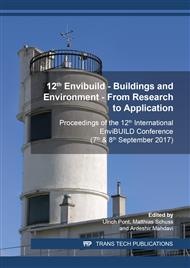p.597
p.605
p.613
p.622
p.633
p.641
p.650
p.659
p.667
Simulation Study of a Novel Solar Thermal Seasonal Heat Storage System Based on Stable Supercooled PCM for Space Heating and Domestic Hot Water Supply of Single Family Houses
Abstract:
A TRNSYS model of a novel PCM heat storage, utilizing stable supercooling of Sodium Acetate Trihydrate (SAT), is presented. To achieve high solar fractions in heat supply of single family houses, the necessary integration of big water volumes is challenging. To evaluate its functionality, a system model of a solar thermal combisystem for space heating and domestic hot water supply for dynamic system simulation was built. The key component is a PCM volume for long term heat storage. While conventional heat storage concepts with SAT release the latent heat a few degrees below the melting temperature, with the concept of stable supercooling latent heat can be stored for long periods of time at ambient temperature. This allows the design of a partly loss-free storage. Solar fractions were evaluated for simulation runs with two building variations. Annual specific space heating demands of 15 and 30 kWh/(m2a) and a domestic hot water demand of a typical single family house were considered. A sensitivity analysis on solar fractions of domestic heat supply was performed by variation of the collector field and the PCM volume. While the increase of the PCM volume from 4.5 m3 to 9 m3 shows moderate effects in all simulation runs, an increase of the collector area has substantial effects on the share of solar heat on the total energy demand of the building.
Info:
Periodical:
Pages:
650-658
Citation:
Online since:
January 2019
Authors:
Price:
Сopyright:
© 2019 Trans Tech Publications Ltd. All Rights Reserved
Share:
Citation:


